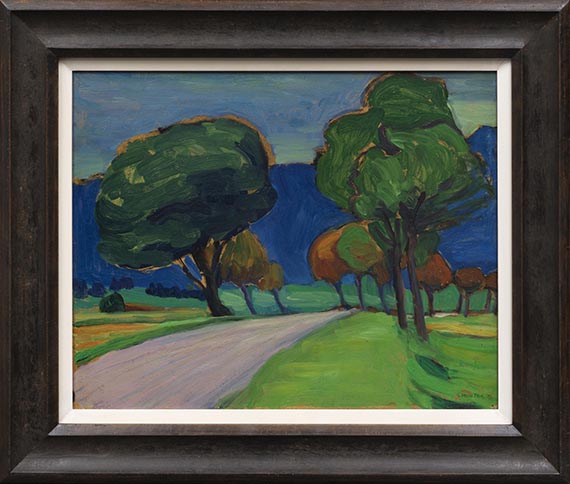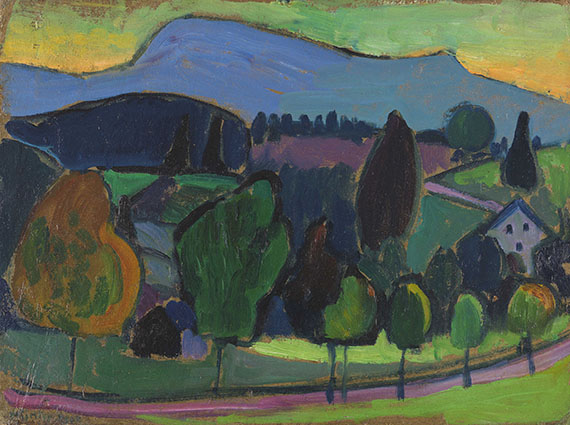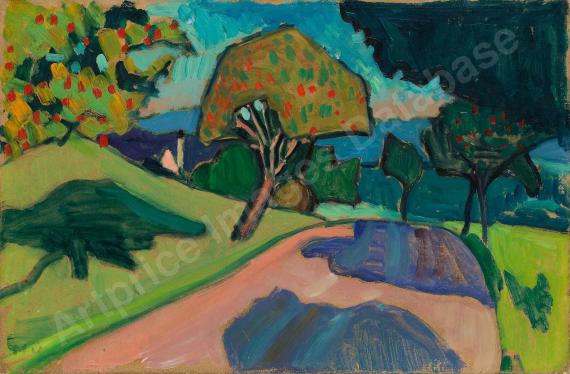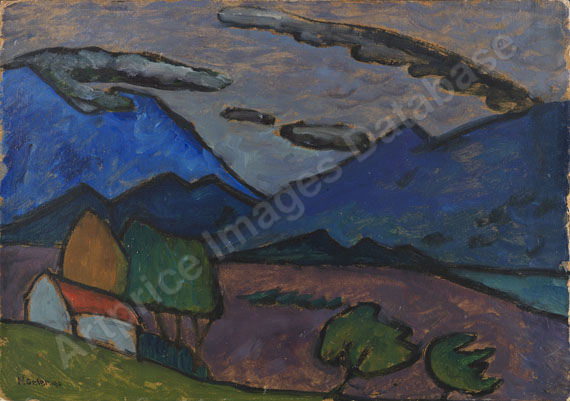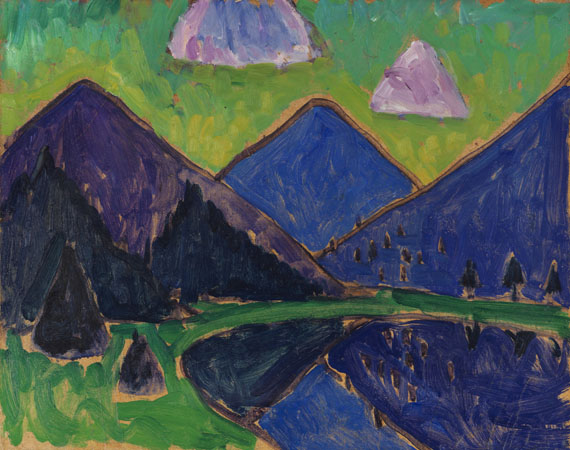2
Gabriele Münter
Straße nach Weilheim, 1908.
Oil on cardboard
Estimation: € 200,000 / $ 214,000
Straße nach Weilheim. 1908.
Oil on cardboard.
Lower right signed and dated, inscribed "23" (by a hand other than that of the artist?). 32.9 x 40.9 cm (12.9 x 16.1 in).
With the inscription "4035" on the reverse.
• Masterpiece from the early Murnau period in 1908, the birth of German Expressionism.
• On their first visit in the summer of 1908, Gabriele Münter and Wassily Kandinsky fell in love with the 'Blue Land'.
• Paintings from this period are among her most sought-after works.
• Murnau landscape in the light of the blue hour - of museum quality.
• Part of a Swiss private collection for many decades
• This year Gabriele Münter is honored in numerous international museum exhibitions (Vienna, Madrid, London and Bern).
Accompanied by a written confirmation of authenticity issued by the Gabriele Münter- and Johannes Eichner-Foundation on December 7, 2023. The painting will be included into the forthcoming catalogue raisonné of Gabriele Münter's paintings.
PROVENANCE: Collection of Dr. med. dent. Detmar Haymann (1891-1985), Zürich.
Ever since family-owned.
Called up: June 7, 2024 - ca. 17.02 h +/- 20 min.
Oil on cardboard.
Lower right signed and dated, inscribed "23" (by a hand other than that of the artist?). 32.9 x 40.9 cm (12.9 x 16.1 in).
With the inscription "4035" on the reverse.
• Masterpiece from the early Murnau period in 1908, the birth of German Expressionism.
• On their first visit in the summer of 1908, Gabriele Münter and Wassily Kandinsky fell in love with the 'Blue Land'.
• Paintings from this period are among her most sought-after works.
• Murnau landscape in the light of the blue hour - of museum quality.
• Part of a Swiss private collection for many decades
• This year Gabriele Münter is honored in numerous international museum exhibitions (Vienna, Madrid, London and Bern).
Accompanied by a written confirmation of authenticity issued by the Gabriele Münter- and Johannes Eichner-Foundation on December 7, 2023. The painting will be included into the forthcoming catalogue raisonné of Gabriele Münter's paintings.
PROVENANCE: Collection of Dr. med. dent. Detmar Haymann (1891-1985), Zürich.
Ever since family-owned.
Called up: June 7, 2024 - ca. 17.02 h +/- 20 min.
"Straße nach Weilheim" (Road to Weilheim) can be brought in connection with a note in the archive of the Gabriele Münter and Johannes Eichner Foundation. It can be assumed that this work depicts the road to Weilheim. In 1908, the year it was built, today's Bundesstraße 2 was still a tranquil country road. Looking south, Gabriele Münter could see the mountain range on the horizon through the trees. It was precisely this view, which contains the essential elements of the so-called "Blaue Land" that fascinated the artist so much.
Our painting was created in what was arguably the most important year of Gabriele Münter's artistic career. In late summer, Gabriele Münter met up with Wassily Kandinsky, Alexej von Jawlensky and Marianne von Werefkin in Murnau for painting sessions. They stayed at the Griesbräu Inn on the Obermarkt and explored the surroundings of the small farming village with their easels and brushes, sketchpads, and pencils, rounded off by discussions about the latest artistic issues and new goals. They had all been traveling over the previous years and were able to draw on the impressions gathered. During this creative shared time away from the social conventions and constraints of Munich, an artistic revolution characterized by great dynamism happened, a radical departure from the Impressionist and late Impressionist style of painting. Here she made a decisive turn towards synthetic, expressive color painting, which would have a decisive influence on subsequent art history.
The vast landscape with the tree-lined avenue and the mountains is shown in homogeneously painted areas and framed by loosely set contours. Gabriele Münter only had to walk along the street that led from her accommodation at the time, the inn "Zum Griesbräu" inn, in the direction of Weilheim, and turn south a little outside the village, to enjoy this expansive view of the landscape, which would accompany her for many years to come and serve as a source of inspiration. In the autumn of 1908, the artist captured the atmospheric landscape with a few, slightly nuanced hues, which was entirely in line with the approach of her companion. (Quoted from: Helmut Friedel, Annegret Hoberg, Der Blaue Reiter, Munich 2000, p. 24).
Looking back in 1911, Gabriele Münter herself confirmed the relevance of the paintings created in the first Murnau autumn: "After a short period of agony, I made a great leap - from painting nature - more or less in impressionist style - to perceiving a meaning - to abstracting - to giving an extract" (B. Salmen, A. Hoberg, in: exhib. cat. 1908/2008 - Vor 100 Jahren. Kandinsky, Münter, Jawlensky, Werefkin in Murnau, Murnau 2008, p.24). Our painting, which has been in the family for many decades and has never been exhibited, is an important creation from this epochal period of awakening. [EH]
Our painting was created in what was arguably the most important year of Gabriele Münter's artistic career. In late summer, Gabriele Münter met up with Wassily Kandinsky, Alexej von Jawlensky and Marianne von Werefkin in Murnau for painting sessions. They stayed at the Griesbräu Inn on the Obermarkt and explored the surroundings of the small farming village with their easels and brushes, sketchpads, and pencils, rounded off by discussions about the latest artistic issues and new goals. They had all been traveling over the previous years and were able to draw on the impressions gathered. During this creative shared time away from the social conventions and constraints of Munich, an artistic revolution characterized by great dynamism happened, a radical departure from the Impressionist and late Impressionist style of painting. Here she made a decisive turn towards synthetic, expressive color painting, which would have a decisive influence on subsequent art history.
The vast landscape with the tree-lined avenue and the mountains is shown in homogeneously painted areas and framed by loosely set contours. Gabriele Münter only had to walk along the street that led from her accommodation at the time, the inn "Zum Griesbräu" inn, in the direction of Weilheim, and turn south a little outside the village, to enjoy this expansive view of the landscape, which would accompany her for many years to come and serve as a source of inspiration. In the autumn of 1908, the artist captured the atmospheric landscape with a few, slightly nuanced hues, which was entirely in line with the approach of her companion. (Quoted from: Helmut Friedel, Annegret Hoberg, Der Blaue Reiter, Munich 2000, p. 24).
Looking back in 1911, Gabriele Münter herself confirmed the relevance of the paintings created in the first Murnau autumn: "After a short period of agony, I made a great leap - from painting nature - more or less in impressionist style - to perceiving a meaning - to abstracting - to giving an extract" (B. Salmen, A. Hoberg, in: exhib. cat. 1908/2008 - Vor 100 Jahren. Kandinsky, Münter, Jawlensky, Werefkin in Murnau, Murnau 2008, p.24). Our painting, which has been in the family for many decades and has never been exhibited, is an important creation from this epochal period of awakening. [EH]
2
Gabriele Münter
Straße nach Weilheim, 1908.
Oil on cardboard
Estimation: € 200,000 / $ 214,000
Commission, taxes et droit de suite
Cet objet est offert avec imposition différentielle majorée d'une taxe à l'importation qui s'élève à 7% (réduction d'environ 5% par rapport à l'imposition régulière) ou avec imposition régulière.
Calcul en cas d'imposition différentielle:
Prix d'adjudication jusqu'à 800 000 € : 32 % de commission.
Prix d'adjudication supérieur à 800 000 € : montants partiels jusqu'à 800 000 € 32 % de commission, montants partiels supérieurs à 800 000 € : 27 % de commission.
Prix d'adjudication supérieur à 4.000 000 € : montants partiels supérieurs à 4.000 000 € : 22 % de commission.
La commission comprend la TVA, laquelle ne figure cependant pas sur la facture.
Calcul en cas d'imposition régulière:
Prix d’adjudication jusqu’à 800 000 euros : frais de vente 27%.
Des frais de vente de 21% sont facturés sur la partie du prix d’adjudication dépassant 800 000 euros. Ils sont additionnés aux frais de vente dus pour la partie du prix d’adjudication allant jusqu’à 800 000 euros.
Des frais de vente de 15 % sont facturés sur la partie du prix d’adjudication dépassant 4 000 000 euros. Ils sont additionnés aux frais de vente dus pour la partie du prix d’adjudication allant jusqu’à 4 000 000 euros.
La taxe sur la valeur ajoutée allemande, actuellement de 19 %, est perçue sur la somme du prix d’adjudication et des frais de vente. Exception : la taxe sur la valeur ajoutée réduite de 7 % est appliquée pour les livres imprimés.
Pour les entreprises habilitées à déduire la TVA, le régime fiscal général peut être appliqué.
Calcul en cas de droit de suite:
Pour les œuvres originales d’arts plastiques et de photographie d’artistes vivants ou d’artistes décédés il y a moins de 70 ans, soumises au droit de suite, une rémunération au titre du droit de suite à hauteur des pourcentages indiqués au § 26, al. 2 de la loi allemande sur les droits d’auteur (UrhG) est facturée en sus pour compenser la rémunération liée au droit de suite due par le commissaire-priseur conformément au § 26 UrhG. À ce jour, elle est calculée comme suit :
4 pour cent pour la part du produit de la vente à partir de 400,00 euros et jusqu’à 50 000 euros,
3 pour cent supplémentaires pour la part du produit de la vente entre 50 000,01 et 200 000 euros,
1 pour cent supplémentaire pour la part entre 200 000,01 et 350 000 euros,
0,5 pour cent supplémentaire pour la part entre 350 000,01 et 500 000 euros et
0,25 pour cent supplémentaire pour la part au-delà de 500 000 euros.
Le total de la rémunération au titre du droit de suite pour une revente s’élève au maximum à 12 500 euros.
Calcul en cas d'imposition différentielle:
Prix d'adjudication jusqu'à 800 000 € : 32 % de commission.
Prix d'adjudication supérieur à 800 000 € : montants partiels jusqu'à 800 000 € 32 % de commission, montants partiels supérieurs à 800 000 € : 27 % de commission.
Prix d'adjudication supérieur à 4.000 000 € : montants partiels supérieurs à 4.000 000 € : 22 % de commission.
La commission comprend la TVA, laquelle ne figure cependant pas sur la facture.
Calcul en cas d'imposition régulière:
Prix d’adjudication jusqu’à 800 000 euros : frais de vente 27%.
Des frais de vente de 21% sont facturés sur la partie du prix d’adjudication dépassant 800 000 euros. Ils sont additionnés aux frais de vente dus pour la partie du prix d’adjudication allant jusqu’à 800 000 euros.
Des frais de vente de 15 % sont facturés sur la partie du prix d’adjudication dépassant 4 000 000 euros. Ils sont additionnés aux frais de vente dus pour la partie du prix d’adjudication allant jusqu’à 4 000 000 euros.
La taxe sur la valeur ajoutée allemande, actuellement de 19 %, est perçue sur la somme du prix d’adjudication et des frais de vente. Exception : la taxe sur la valeur ajoutée réduite de 7 % est appliquée pour les livres imprimés.
Pour les entreprises habilitées à déduire la TVA, le régime fiscal général peut être appliqué.
Calcul en cas de droit de suite:
Pour les œuvres originales d’arts plastiques et de photographie d’artistes vivants ou d’artistes décédés il y a moins de 70 ans, soumises au droit de suite, une rémunération au titre du droit de suite à hauteur des pourcentages indiqués au § 26, al. 2 de la loi allemande sur les droits d’auteur (UrhG) est facturée en sus pour compenser la rémunération liée au droit de suite due par le commissaire-priseur conformément au § 26 UrhG. À ce jour, elle est calculée comme suit :
4 pour cent pour la part du produit de la vente à partir de 400,00 euros et jusqu’à 50 000 euros,
3 pour cent supplémentaires pour la part du produit de la vente entre 50 000,01 et 200 000 euros,
1 pour cent supplémentaire pour la part entre 200 000,01 et 350 000 euros,
0,5 pour cent supplémentaire pour la part entre 350 000,01 et 500 000 euros et
0,25 pour cent supplémentaire pour la part au-delà de 500 000 euros.
Le total de la rémunération au titre du droit de suite pour une revente s’élève au maximum à 12 500 euros.




 Lot 2
Lot 2 